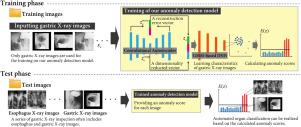Computers in Biology and Medicine ( IF 7.0 ) Pub Date : 2020-07-08 , DOI: 10.1016/j.compbiomed.2020.103903 Ren Togo 1 , Haruna Watanabe 2 , Takahiro Ogawa 2 , Miki Haseyama 2

|
Aim:
The aim of this study was to determine whether our deep convolutional neural network-based anomaly detection model can distinguish differences in esophagus images and stomach images obtained from gastric X-ray examinations.
Methods:
A total of 6012 subjects were analyzed as our study subjects. Since the number of esophagus X-ray images is much smaller than the number of gastric X-ray images taken in X-ray examinations, we took an anomaly detection approach to realize the task of organ classification. We constructed a deep autoencoding gaussian mixture model (DAGMM) with a convolutional autoencoder architecture. The trained model can produce an anomaly score for a given test X-ray image. For comparison, the original DAGMM, AnoGAN, and a One-Class Support Vector Machine (OCSVM) that were trained with features obtained by a pre-trained Inception-v3 network were used.
Results:
Sensitivity, specificity, and the calculated harmonic mean of the proposed method were 0.956, 0.980, and 0.968, respectively. Those of the original DAGMM were 0.932, 0.883, and 0.907, respectively. Those of AnoGAN were 0.835, 0.833, and 0.834, respectively, and those of OCSVM were 0.932, 0.935, and 0.934, respectively. Experimental results showed the effectiveness of the proposed method for an organ classification task.
Conclusion:
Our deep convolutional neural network-based anomaly detection model has shown the potential for clinical use in organ classification.
中文翻译:

基于深度卷积神经网络的胃X线检查器官分类的异常检测。
目标:
这项研究的目的是确定我们基于深度卷积神经网络的异常检测模型是否可以区分通过胃部X射线检查获得的食道图像和胃图像的差异。
方法:
共分析了6012名受试者作为我们的研究受试者。由于食管X射线图像的数量远少于X射线检查中拍摄的胃X射线图像的数量,因此我们采取了一种异常检测方法来实现器官分类的任务。我们使用卷积自动编码器架构构建了一个深度自动编码高斯混合模型(DAGMM)。训练后的模型可以为给定的测试X射线图像生成异常评分。为了进行比较,使用了原始DAGMM,AnoGAN和一类支持向量机(OCSVM),它们使用通过预训练的Inception-v3网络获得的功能进行了训练。
结果:
该方法的灵敏度,特异性和计算的谐波平均值分别为0.956、0.980和0.968。原始DAGMM的那些分别为0.932、0.883和0.907。AnoGAN的分别为0.835、0.833和0.834,OCSVM的分别为0.932、0.935和0.934。实验结果表明了该方法对器官分类任务的有效性。
结论:
我们基于深度卷积神经网络的异常检测模型显示出在器官分类中临床应用的潜力。











































 京公网安备 11010802027423号
京公网安备 11010802027423号